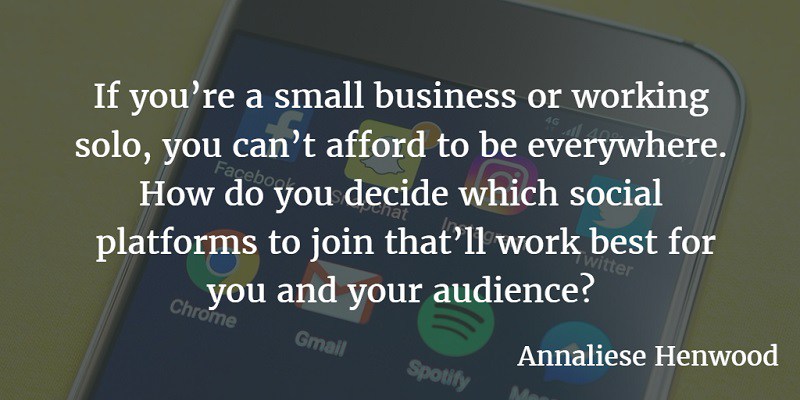Author: Annaliese Henwood / Source: Business 2 Community Whenever we turn around, there’s either a new big feature or new social platform
Whenever we turn around, there’s either a new big feature or new social platform available with full business opportunity. We used to have the typical Facebook and Twitter platforms, but now there’s Instagram, Pinterest, Snapchat, LinkedIn…
If you’re a small business or working solo, you can’t afford to be everywhere. How do you decide which platforms to join that’ll work best for you and your audience?

You have seven factors to evaluate per platform. To make it easier for you, you can consider platforms as a whole, using these factors. This would be more efficient than going through every platform individually and help you target your business needs more precisely.
— — —
1) Audience
First and foremost, you need to research your target audience. You’ll want to find them first because they are who will bring you business. Where are they most active? Or, more importantly, where are they actively seeking you out? Do they mention you on a consistent basis on Twitter? Even if they’re really active on Instagram, do they want to see you there?
People can be quite widespread on social media as a whole. There are so many platforms to choose from. The best way to evaluate audience involvement is to examine the demographics of each platform. HubSpot does a great job at making this easy with their 2017 benchmark infographic.
These are just a few of the highlights:
- Facebook is the best place to reach Millennials and Generation X (ages 18-49)
- YouTube reaches more 18-49 year olds than any cable network in the USA
- 53% of Instagram users follow brands
- People who follow a product link via Pinterest are 10% more likely to make a purchase than users of other social networks
You can find other key platform statistics on HubSpot’s website.
Regardless of your business or personal preferences, you need to remember that your social media marketing won’t be effective if you aren’t paying attention to your audience’s own preferences. They have the final say as to which platforms you should be on. At this point, you should have a list, so now it’s time to narrow that down. If it’s a short list, it’s time to see which platforms should have the highest investment.
2) Content type
Yes, there are many social networks out there these days. Do you feel overwhelmed by that list? That’s nothing if you consider how many unique content features each platform has. It can be quite daunting, so how do you determine which platform is right based on these content types?
Similar to the audience analysis from before, you don’t want to focus on your own preferences here. The content you choose should be what your target audience wants to see from you. Even if you prefer the written word, video is a huge, dominating part of social engagement now. You’ll need to adapt if you want to see your social efforts bring results.
Which content types are most popular these days?
- Video in the form of prerecorded or live streaming
- Image sharing
- GIFs and emojis
If you’re not ready to create the above content, you need to get moving on that. Your audience isn’t going to wait for you to do this either. They’ll go straight to your competitors if you take too long.
When you’re ready to create a content type that appeals to your target audience, it’s time to find out which platforms lead the way with that format.
Which platforms are emphasizing these content types?
- Snapchat, Instagram, and Facebook all offer live-streaming services in one form or another. Social Media Examiner has an article to help you decide which platform is best for live video.
- YouTube is the ultimate place to host your recorded videos. Moz has a rather thorough article emphasizing YouTube’s marketing value. It’s an older article, but it still has a lot of great advice.
- Instagram and Pinterest are the leaders in image sharing. Even if you’re not a designer, you can create images that appeal to your audience. Buffer published an article on creating engaging images that focuses on non-designers.
- Twitter users love GIFs and emojis. Hootsuite offers two definitive articles on these features. Their GIFs guide gives you clear instructions on where to find them and how to make them yourself. Their emoji guide helps you understand best practices for when and how to use them.
This is another way you can determine which social media platform your business should be on, but there are still five other key elements you must evaluate.
3) Frequency
Yes, you want to be where your audience is seeking you out, but you need to be ready for what that entails. Some social networks require a heavy time commitment.
Let’s examine a few of the most common frequencies:
Twitter requires posting content at least five times a day. This doesn’t include the real-time engagement and interactions you should offer. Twitter is a fast-paced platform, and if you’re not tweeting a lot, you won’t reach your target audience enough.
Pinterest content has a really long shelf-life, so it’s not a place where you need to create a lot of pins every day (although you still can). Some say you can pin up to five times a day, but a minimum of one a day can still drive traffic because of its evergreen nature.
Instagram has a great…

COMMENTS